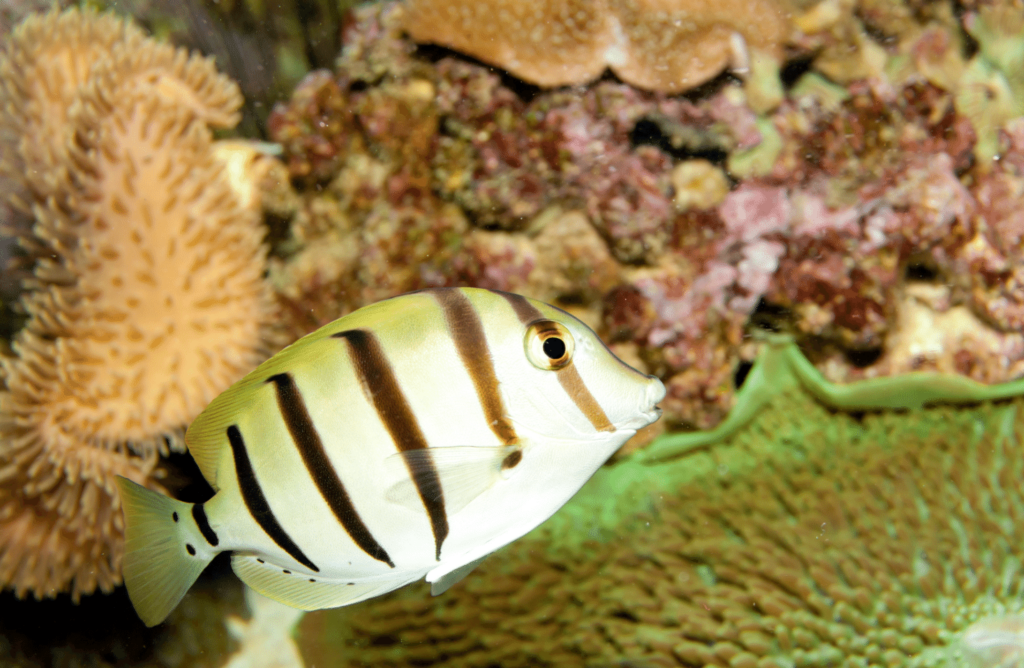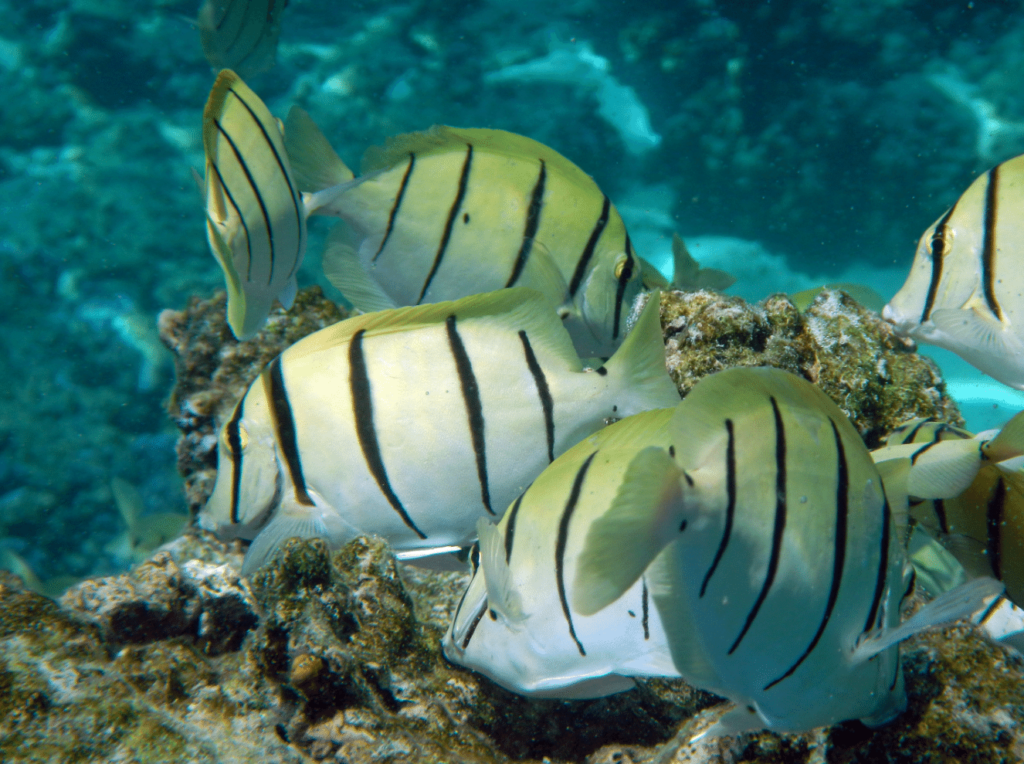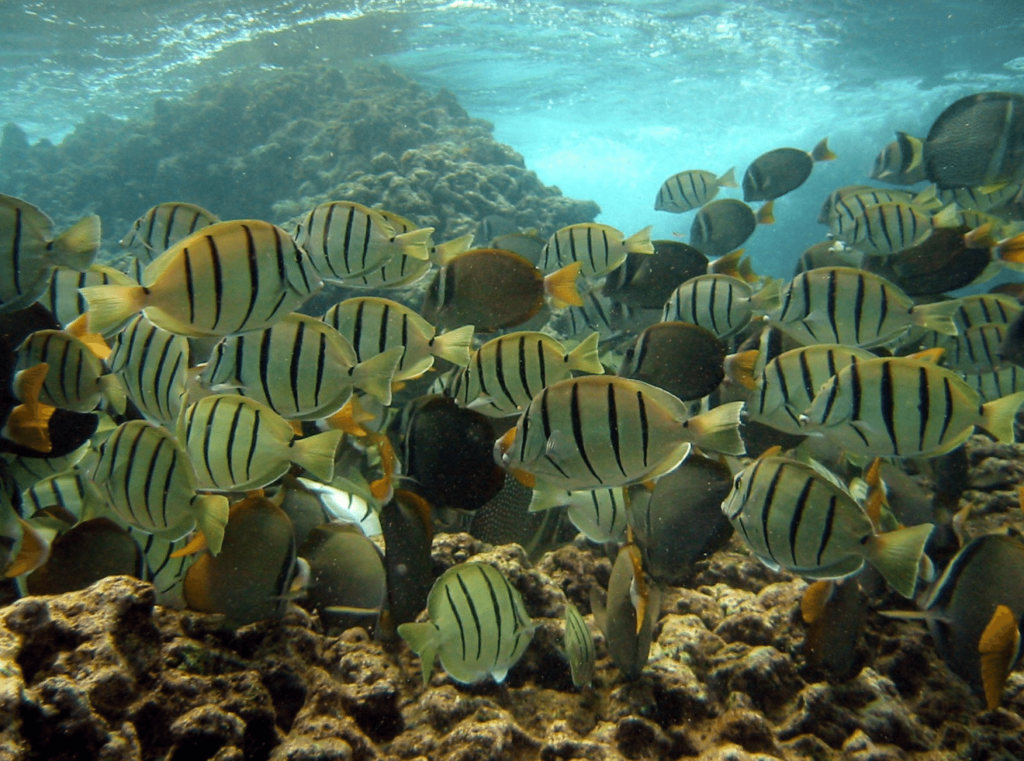Your cart is currently empty!

The Convict Tang: An Underwater Striped Marvel
The Convict Tang, scientifically known as Acanthurus Triostegus, is a fascinating marine fish that captures the attention of ocean enthusiasts and aquarists alike. Its distinct black stripes running vertically across its body give it a striking appearance, reminiscent of a traditional prison uniform, which is how it earned the name “Convict Tang.”
Key Characteristics of Convict Tang

Here are the key characteristics of the Convict Tang:
Physical
- Appearance: The Convict Tang has a distinctive white to pale yellow body covered in six vertical black bars, resembling the stripes of a convict’s uniform, hence the name.
- Size: Adults typically grow to about 15-20 cm (6-8 inches) in length.
- Shape: They have a laterally compressed body typical of tangs, with a sharp spine on either side of the tail, which can be used for defense.
Habitat
- Distribution: This species is widely distributed throughout the Indo-Pacific region, including the waters around the Hawaiian Islands, the Great Barrier Reef, and the Red Sea.
- Habitat: They are commonly found in shallow reef environments, often in lagoons and outer reef slopes. They prefer areas with abundant coral and rocky substrates where they can graze on algae.
Behavior
- Social Structure: They are often seen in schools, especially when feeding. These schools can consist of hundreds of individuals, offering protection from predators and increasing feeding efficiency.
- Reproduction: Spawning typically occurs in pairs or groups. They release eggs into the water column, where fertilization occurs. The larvae are planktonic, drifting with ocean currents before settling on the reef.
Natural Diet in the Wild

In the wild, Convict Tangs primarily graze on algae, which forms the bulk of their diet. They are herbivores, and their natural feeding behavior involves scraping algae off rocks and coral surfaces. This diet is rich in nutrients and fiber, which are crucial for their digestive health.
Algae-Based Foods
To replicate their natural diet, the primary food source for your Convict Tang should be algae-based. Here are some options:
- Nori (Dried Seaweed): Nori sheets are an excellent source of nutrition for Convict Tangs. They are high in vitamins and minerals and can be easily attached to a clip inside the tank for the fish to graze on throughout the day.
- Spirulina: Spirulina flakes or pellets are another great algae-based food. Spirulina is rich in proteins, vitamins, and essential fatty acids, which promote vibrant colors and overall health.
- Fresh Macro-algae: Fresh Macro-algae like Gracilaria or Chaetomorpha can be introduced into the tank. These provide a natural grazing experience and are packed with nutrients.
Ecological Role
- Grazers: By feeding on algae, Convict Tangs help control algal populations on coral reefs, essential for the health and balance of reef ecosystems.
- Indicator Species: Their presence and abundance can indicate the health of coral reef environments, as they are sensitive to changes in water quality and habitat conditions.
Adaptations
- Body Structure: Their compressed bodies and sharp caudal spines help them navigate and protect themselves in the reef environment.
- Schooling Behavior: Schooling provides safety in numbers, reducing the likelihood of individual predation and increasing foraging success.
Conservation Status
- Population: Currently, the Convict Tang is not considered endangered. However, like many reef species, they are susceptible to habitat degradation, pollution, and the effects of climate change.
- Protection Measures: Conservation efforts to protect coral reefs, such as marine protected areas (MPAs) and sustainable fishing practices, are essential for the continued health of Convict Tang populations.
Caring for Convict Tang in Aquariums

Caring for Convict Tangs (Acanthurus Triostegus) in aquariums requires understanding their natural habitat and needs to ensure they thrive in captivity. Here’s a comprehensive guide on how to care for Convict Tangs:
Tank Requirements
To keep a Convict Tang healthy and happy in an aquarium, a spacious tank with a minimum size of 75 gallons (285 liters) is recommended. Plenty of live rock and hiding spots are essential, as these structures mimic their natural habitat and offer places for the fish to seek refuge. Strong water flow and efficient filtration are also important in replicating their natural environment and maintaining water quality.
Social Compatibility
Convict Tangs are peaceful but can exhibit territorial behavior, especially towards other tangs or similar-looking fish. It’s best to introduce them to the tank with other non-aggressive species to maintain harmony. If multiple tangs are kept together, ensure the tank is large enough to accommodate their space needs and reduce territorial disputes.
Health and Disease Prevention
Maintaining optimal water quality and a balanced diet is vital to preventing common fish diseases. Convict Tangs can be susceptible to marine ich and other parasitic infections, so regular monitoring and prompt treatment are essential. Quarantining new additions before introducing them to the main tank can help prevent the spread of diseases.
Color Adaptation
Did you know that Convict Tangs can change their coloration slightly based on their mood or environment? Their colors may dull or darken when stressed or frightened, whereas a healthy, relaxed tang will display vibrant stripes. This adaptability makes them even more intriguing to observe, whether in the wild or in an aquarium.
Longevity
Convict Tangs can live for over 10 years in captivity with proper care. Their long lifespan and relatively easy care requirements make them a rewarding choice for dedicated aquarists.
Conservation Status
Currently, Convict Tangs are not considered endangered. However, preserving their natural habitats is crucial to ensuring their populations remain healthy. Efforts to protect coral reefs benefit these fish and countless other marine species. Sustainable aquarium practices, such as captive breeding, also help reduce the impact on wild populations.
Boca Aquarium: A Unique Destination for Marine Life and Luxury
Combine the allure of world-class marine exhibits with the elegance of exclusive jewelry shopping at Diamonds by Raymond Lee. The Boca Aquarium offers a distinctive experience where you can marvel at the beauty of aquatic life and enjoy the luxury of fine jewelry in one location.
Our aquarium features stunning exhibits of sharks, colorful reefs, and diverse sea creatures, providing endless excitement and wonder. Plan your visit to the Boca Aquarium today and discover why it’s a must-visit destination in Boca Raton. Experience the perfect blend of marine wonder and luxury shopping now!
